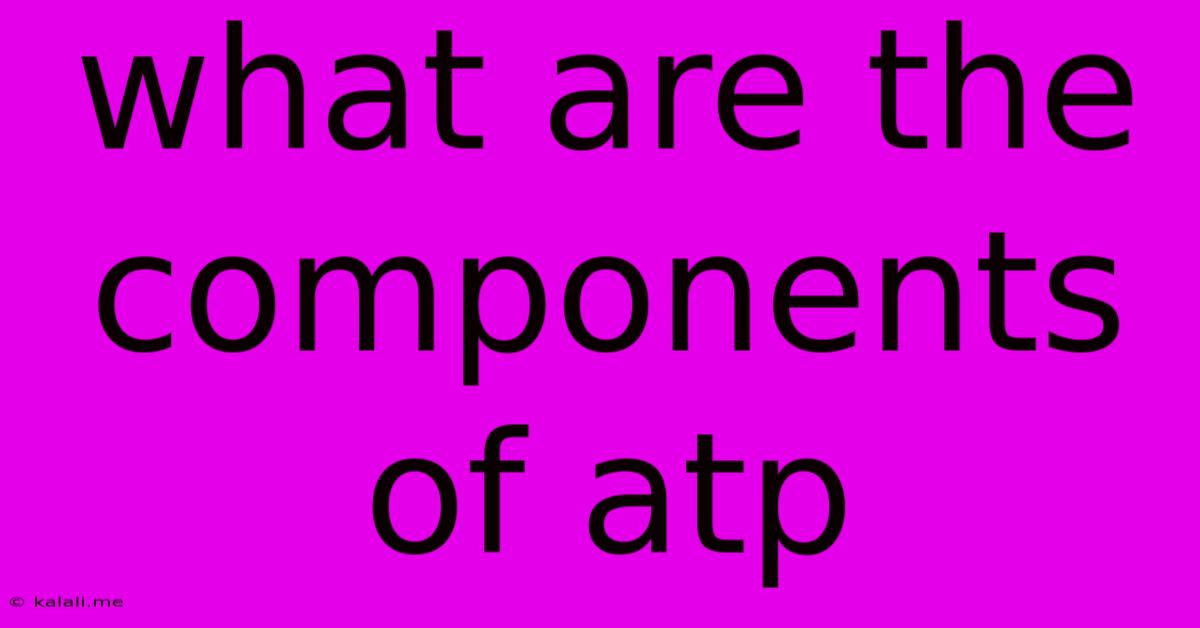What Are The Components Of Atp
Kalali
May 09, 2025 · 3 min read

Table of Contents
What are the Components of ATP? Understanding the Energy Currency of Life
ATP, or adenosine triphosphate, is often called the "energy currency" of a cell. This molecule is crucial for countless biological processes, from muscle contraction to DNA replication. But what exactly makes ATP so energetic? Understanding its components is key to grasping its function. This article will explore the building blocks of ATP and how they contribute to its vital role in cellular energy transfer.
ATP is composed of three main components:
-
Adenine: A nitrogenous base, adenine is a purine molecule with a double-ring structure. It's one of the fundamental building blocks of nucleic acids (DNA and RNA) and plays a critical role in many cellular processes beyond ATP's energy function. Its presence in ATP is crucial for recognition and interaction with various enzymes involved in ATP metabolism.
-
Ribose: A five-carbon sugar, ribose forms the backbone of ATP. Specifically, it's a pentose sugar, meaning it has five carbon atoms. The ribose molecule acts as a scaffold, linking adenine to the phosphate groups. Its structure is vital for maintaining the overall stability and shape of the ATP molecule, influencing its interactions with other molecules. Understanding ribose's role helps us comprehend the precise geometry of the molecule, impacting its function within enzymes.
-
Triphosphate Group: This is the energy-rich part of ATP. It consists of three phosphate groups linked together. These phosphate groups are negatively charged, and their proximity creates significant electrostatic repulsion. This repulsion stores a substantial amount of potential energy. The hydrolysis of these phosphate bonds – specifically, the breaking of the bond between the second and third phosphate groups – releases this energy, making it available for cellular work. This process is often referred to as ATP hydrolysis and is a fundamental process in cellular energy transfer.
The Importance of Phosphate Bonds
The high-energy phosphate bonds are crucial. Breaking these bonds releases a significant amount of energy, which cells can then harness to power various processes. This energy release drives numerous reactions, including:
-
Muscle contraction: The energy released from ATP hydrolysis fuels the interaction between actin and myosin filaments, leading to muscle contraction.
-
Active transport: Cells use ATP to move molecules against their concentration gradient, a process vital for maintaining cellular homeostasis. This includes transporting ions across cell membranes and reabsorbing nutrients from the digestive tract.
-
Protein synthesis: ATP is necessary for the complex process of building proteins from amino acids. The energy is required for the formation of peptide bonds.
-
Nerve impulse transmission: The transmission of nerve impulses relies on the energy released from ATP hydrolysis to facilitate the movement of ions across neuronal membranes.
ATP Regeneration
While ATP is constantly used and broken down, it's continuously regenerated through cellular respiration. This process involves several pathways, primarily oxidative phosphorylation in the mitochondria, converting energy from food into ATP. The efficiency of this regeneration is vital for maintaining cellular energy levels and sustaining life.
In conclusion, understanding the components of ATP – adenine, ribose, and the triphosphate group – provides a clearer picture of how this remarkable molecule functions as the energy currency of life. The high-energy phosphate bonds are the key to its energy-releasing capabilities, allowing cells to power the numerous processes essential for survival. The efficient regeneration of ATP through cellular respiration ensures a constant supply of this vital energy molecule.
Latest Posts
Latest Posts
-
How Many Cups Is 3 4 Pint
May 09, 2025
-
How Tall Is 170cm In Inches
May 09, 2025
-
How To Graph A No Solution
May 09, 2025
-
Factoring A Quadratic With Leading Coefficient
May 09, 2025
-
Convertir 70 Grados Fahrenheit A Centigrados
May 09, 2025
Related Post
Thank you for visiting our website which covers about What Are The Components Of Atp . We hope the information provided has been useful to you. Feel free to contact us if you have any questions or need further assistance. See you next time and don't miss to bookmark.